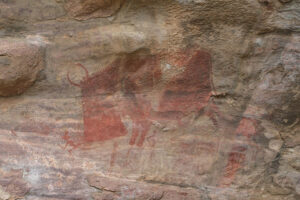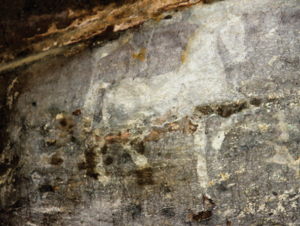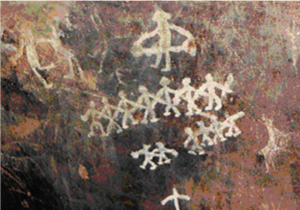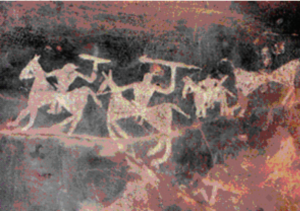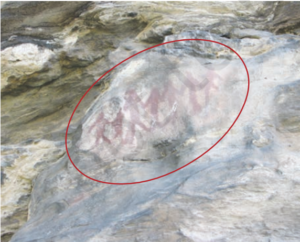Prehistoric Art: Mesolithic rock painting
- In the distant past when there was no paper or language or the written word, and hence no books or written documents, how people lived in those times can be constructed by old tools, pottery, habitats, bones of ancient human beings and animals, and drawings on cave walls.
- Painting and drawing were the oldest art forms practiced by human beings to express themselves, using the cave walls as their canvas.
- Prehistoric paintings have been found in many parts of the world. We do not really know if Lower Palaeolithic people ever produced any art objects. But by the Upper Palaeolithic times we see a proliferation of artistic activities. Around the world the walls of many caves of this time are full of finely carved and painted pictures of animals which the cave-dwellers hunted.
- The subjects of their drawings were human figures, human activities, geometric designs and animal symbols.
- In India the earliest paintings have been reported from the Upper Palaeolithic times.
- The rock paintings were an important and distinct feature of the Mesolithic people. These paintings are made on the walls of rock shelters, maximum of which have been found at Bhimbetka in Madhya Pradesh. These throw light on the social and economic life on Mesolithic people.
- They may have drawn and painted to make their shelters more colourful and beautiful or to keep a visual record of their day-to-day life, like some of us who maintain a diary.
- Remnants of rock paintings have been found on the walls of the caves situated in several districts of Madhya Pradesh, Uttar Pradesh, Andhra Pradesh, Karnataka and Bihar. Some paintings have been reported from the Kumaon hills in Uttarakhand like in Lakhudiyar.
- Prehistoric rock cave paintings help us to understand about early human beings, their lifestyle, their food habits, their daily activities and, above all, they help us understand their mind—the way they thought.
- When the basic needs of food, water, clothing and shelter were fulfilled people felt the need to express their creative urges.
-
- They may have drawn and painted to decorate their homes, or to tell a story in pictures or to keep a visual record of their day-to-day life or to tell a story in pictures.
- Some scenes may have been picture-stories of memorable events in their lives. The primitive artists seem to possess an intrinsic passion for storytelling.
- Others may have been connected with rituals connected with hunting or fertility.
- Apart from the scenes of animals and people, there are a few more enigmatic paintings. A very interesting, rather abstract painting has been found in a rock shelter at Jaora (MP). Perhaps it reflects a view of the world consisting of air, earth, and fire.
- The richest paintings are reported from the Vindhya ranges of Madhya Pradesh. These hill ranges are full of Palaeolithic and Mesolithic remains.
- Among these the largest and most spectacular rock-shelter is located in the Vindhya hills at Bhimbetka in Madhya Pradesh.
- Though the rock painting seems to have started from upper Palaeolithic period, largest number of paintings belong to Mesolithic period. During this period the themes multiply.
- Bhimbetka have about eight hundred rock shelters, five hundred of which bear paintings.
- The themes of paintings found here are of great variety, ranging from mundane events of daily life in those times to sacred and royal images.
- These include hunting, dancing, music, horse and elephant riders, animal fighting, honey collection, decoration of bodies, and other household scenes.
- Colors:
- The artists of Bhimbetka used many colours, including various shades of white, yellow, orange, red ochre, purple, brown, green and black. Sixteen colours or shades can be identified in Bhimbetka.
- White and red were their favourite colours.
- Some paintings are monochrome (in one colour), while others are polychrome (in more than one colour).
- The paints were made by grinding various rocks and minerals.
- They got red from haematite.
- The green came from a green variety of a stone called chalcedony.
- White might have been made out of limestone.
- The rock of mineral was first ground into a powder. This may then have been mixed with water and also with some thick or sticky substance.
- The handles of brushes must have been made from twigs, and the brush itself out of squirrel tail, animal fur, semal (silk cotton) or plant fibre.
- These colours have survived thousands of years of adverse weather conditions. Probably the colours have remained intact because of the chemical reaction of the oxide present on the surface of the rocks.
- Hunting scenes:
- Hunting scenes predominate.
- Hunters hunt singly or in groups, sometimes wearing masks and headdresses crowned with antlers and horns. They are adorned with ornaments such as necklaces, bangles, wrist bands, elbow bands, and knee bands with tassels.
- Some are unarmed; others carry sticks, spears, bows and arrows, or slings.
- The hunters are sometimes accompanied by dogs.
- There are scenes showing traps and snares probably to catch animals.
- In some pictures, animals are chasing men. In others they are being chased and hunted by men.
- The hunters are shown wearing simple clothes and ornaments.
- Sometimes, men have been adorned with elaborate head-dresses, and sometimes painted with masks also.
- Animal painting predominated:
- The Mesolithic artists loved to paint animals.
- In Mesolithic art at Bhimbetka and elsewhere, animals are represented on their own or as part of hunting scenes.
- While some of the animal figures are rather abstract, many of them are very realistic.
- Twenty-nine species of animals are depicted, including the chital (this occurs most often), leopard, tiger, panther, elephant, rhinoceros, antelope, deer, and squirrel.
- Different kinds of birds, fish, lizards, frogs, crabs, scorpions, and small centipedes also make an appearance.
- No snakes are depicted in Indian Mesolithic paintings, here or elsewhere.
- There are also fantastic animals—the famous Bhimbetka ‘boar’ has the body of a boar.
- Some of the animal paintings, especially in the hunting scenes, show a fear of animals, but many others show a feeling of tenderness and love for them.
- In one of the scenes, a group of people have been shown hunting a bison. In the process, some injured men are depicted lying scattered on the ground. In another scene, an animal is shown in the agony of death and the men are depicted dancing. These kinds of paintings might have given man a sense of power over the animals he would meet in the open.
- These pictures depict both men and animals engaged in the struggle for survival.
- Animals are sometimes shown in outline; in other instances their bodies are decorated with designs.
- A few paintings are in the ‘x-ray style’, showing the inner organs, including foetuses in the womb of female animals.
- Apart from hunting scenes, animals appear in more peaceful, sympathetic scenes such as those depicting pregnant animals, a panther or tiger with cubs, stag, and chital running after a fawn, grazing buffaloes, rabbits hopping, and monkeys leaping about. There is a lot of movement in the scenes.
- There are also a few engravings representing mainly animals.
- Human painting with activities:
- Mesolithic paintings at Bhimbetka and other sites also depict men and women, young and old.
- Though animals were painted in a naturalistic style, humans were depicted only in a stylistic manner.
- Male figures often look like matchsticks, women are sometimes given fuller forms.
- Women are painted both in the nude and clothed.
- Some men wear loincloths, probably made of leaves, animal skin, or pieces of tree bark. Men wear their hair loose, women braided.
- Some figures are broad and decorated with geometric designs, and from their attitude seem to represent men of authority.
- Children are painted running, jumping and playing.
- There are paintings of people gathering fruit or honey from trees, and of women grinding and preparing food.
- Some of the pictures of men, women and children seem to depict a sort of family life.
- Some scenes depict sexual activity.
- Division of labor:
- The Bhimbetka paintings reflect a division of labour on the basis of gender.
- Men hunt and women are shown gathering and preparing food, for instance grinding food on querns.
- Basket-like containers must have been used to store food, but no pottery is depicted.
- Dry gourds and leather bags may have been used to hold water.
- Dancing:
- Some scenes show people dancing. Community dances provide a common theme.
- The dancers convey a sense of rhythmic movement; occasionally they lose their balance and fall.
- Masked dancers (referred to by prehistorians as ‘dancing sorcerers’) may represent ritual specialists.
- Some hand-linked figures in dancing mode are shown. In fact, this is a recurrent theme.
- Hand, fist, and finger prints are also found, similar to those that people make on their houses these days on auspicious occasions.
- Place of painting:
- The artists here made their paintings on the walls and ceilings of the rock shelters.
- Some of the paintings are reported from the shelters where people lived.
- But some others were made in places which do not seem to have been living spaces at all. Perhaps these places had some religious importance.
- Some of the paintings are very high up on rock shelters or close to the ceilings of rockshelters. The paintings made at these places were perhaps for people to be able to notice them from a distance.
- Some of the big paintings on high surfaces would have required scaffolding and the cooperation of many people. Such paintings, and those made in layers, suggest some kind of ritualistic significance.
- Layer of painting:
- At many rock-art sites, a new painting is painted on top of an older painting. At Bhimbetka, in some places, there are as many as 20 layers of paintings, one on top of another.
- Maybe, this was because the artist did not like his creation and painted another painting on the previous one, or some of the paintings and places were considered sacred or special or this was because the area may have been used by different generations of people at different times.
- Pictorial quality:
- The paintings, though from the remote past, do not lack pictorial quality.
- Despite various limitations such as acute working conditions, inadequate tools, materials, etc., there is a charm of simple rendering of scenes of the environment in which the artists lived.
- The men shown in them appear adventurous and rejoicing in their lives. The animals are shown more youthful and majestic than perhaps they actually were.
- Mesolithic rock art of Orissa:
- Mesolithic shelters with rock art have been identified in the western districts of Orissa, especially in the Sundargarh and Sambalpur districts. The richest area for rock paintings are the 12 rock shelters of the Lekhamoda group.
- An interesting feature of the rock art of Orissa is the co-existence of paintings and engravings in the same shelter.
- Also, the art is mostly non-figurative, with an emphasis on abstract patterns and decorative designs, both geometric and non-geometric.
- Animals occur infrequently, and humans are even rarer.
The rock paintings were an important and distinct feature of the Mesolithic people though their beginning may be traced to the upper Palaeolithic period. These paintings are made on the walls of rock shelters, maximum of which have been found at Bhimbetka in Madhya Pradesh.
In eastern India, over 55 rock shelters with rock art have been identified in the western districts of Orissa, especially in the Sundargarh and Sambalpur districts. An interesting feature of the rock art of Orissa is the co-existence of paintings and en- gravings in the same shelter. Also, the art is mostly non-figurative, with an emphasis on abstract patterns and decorative designs.
Apart from paintings on rocks, rock art includes petroglyphs, a word used when some substance of a rock surface is removed through engraving, bruising, hammering, chiselling etc. Some of them seem to have had some sort of cul tic or religious significance. In India, however, there is very little evidence of palaeo lithic art.
The site of Baghor I in Madhya Pradesh has given fascinating evidence of an upper palaeolithic shrine . Here, there was a roughly circular platform made of sandstone rubble. In the centre was a piece of natural stone with a striking pattern of concentric triangular laminations.
